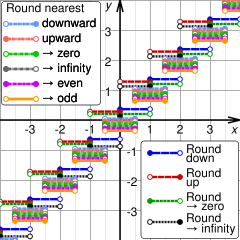Comprehensive post inbound;

math.floor always rounds all numbers to the next whole number towards negative infinity;
math.ceil always rounds all numbers to the next whole number towards positive infinity;
There are two more options for "basic" rounding, towards zero, and away from zero; the former is usually called truncation, the latter doesn't really have a name, but both can be implemented quite easily.
The bigger problems come from when a number is exactly .5 away from any integer, since its nearest integers are the same in both directions; with the above four, it's a non-issue, since they always round towards the directions i mentioned, regardless of the fractional part, that's why they're also called directed rounding functions; for the latter one though, you need to choose a tie-breaking function.
What tjakka linked above is the one that "rounds up" (towards positive infinity), and is the most common one (well, either this or the towards both infinities, but the difference only comes up with the negative numbers).
Here's the two additional functions that aren't built-in to lua, for reference.
(copied from this previous post i made regarding this.)
Code: Select all
math.trunc = function(n) return n >= 0.0 and n-n% 1 or n-n%-1 end -- rounds towards zero, away from both infinities.
math.round = function(n) return n >= 0.0 and n-n%-1 or n-n% 1 end -- rounds away from zero, towards both infinities.
Also,
here's the relevant wikipedia link, and to be honest, this image is awesome in showing what i mean (it's an interactive svg, click the image to go there):

The four on the right are the four i mentioned first, directed rounding; the six on the left are various tie-breaking rules for rounding to the "nearest integer". One isn't limited to those six tie-breakers either, the wikipedia article lists at least two more. (stochastic, i.e. random, and alternating)
